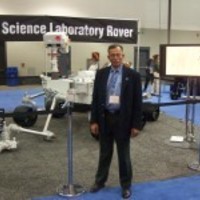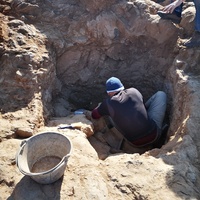Papers by Hanna Rothkaehl
arXiv (Cornell University), Dec 19, 2022
This paper introduces the first results of observations with the Ultra-Long-Wavelength (ULW)-Low ... more This paper introduces the first results of observations with the Ultra-Long-Wavelength (ULW)-Low Frequency Interferometer and Spectrometer (LFIS) on board the selenocentric satellite Longjiang-2. We present a brief description of the satellite and focus on the LFIS payload. The in-orbit commissioning confirmed a reliable operational status of the instrumentation. We also present results of a transition observation, which offers unique measurements on several novel aspects. We estimate the RFI suppression required for such a radio astronomy instrumentation at the Moon distances from Earth to be of the order of 80 dB. We analyse a method of separating Earth-and satellite-originated radio frequency interference (RFI). It is found that the RFI level at frequencies lower than a few MHz is smaller than the receiver noise floor.

<p>The flyby of a dynamically new ... more <p>The flyby of a dynamically new comet by ESA-F1 Comet Interceptor spacecraft offers unique multi-point opportunities for studying the comet's dusty and ionised cometary  environment in ways that were not possible with previous missions, including Rosetta. As Comet Interceptor is an F-class mission, the payload is limited in terms of mass, power, and heritage. Most in situ science sensors therefore have been tightly integrated into a single Dust-Field-Plasma (DFP) instrument on the main spacecraft A and on the ESA sub-spacecraft B2, while there is a Plasma Package suite on the JAXA second sub-spacecraft B1. The advantage of tight integration is an important reduction of mass, power, and especially complexity, by keeping the electrical and data interfaces of the sensors internal to the DFP instrument.</p><p>The full diagnostics located on the board of the 3 spacecrafts will allow  to modeling the comet environment and described the complex physical processes around the comet and on their surface including also the  description of wave particle  interaction in dusty cometary plasma. </p><p>The full set of DFP instrument on  board the Comet Interceptor  spacecraft will allow to model  the comet plasma environment and its interaction with the solar wind. It will also allow to describe the complex physical processes taking place including wave particle  interaction in dusty cometary plasma . </p><p>On spacecraft A, DFP consists of a magnetometer, a Langmuir and multi impedance probe/electric field instrument, an ion and an electron analyzer, a dust sensor, and a central data processing unit and electronics box. On spacecraft B2, the instrumentation is limited to a magnetometer and a dust sensor. The choice of sensors and their capabilities are such that it maximizes synergies and complementarities. </p><p>To give one example: While the dust instrument aims at establishing the dust spectrum for millimeter to micrometer sized particles, the Langmuir probes aided by the data processing unit will analyze the signatures of micrometer to nanometer sized particles.</p><p>Moreover, unique multi-point measurements will be obtained from magnetometers on the three spacecraft, from dust sensors on A and B2, and from ion measurements on A and B1.</p><p>The tight integration of dust-field-plasma sensor hardware and science targets embodied by DFP promises an optimized science return for the available resources.</p>

In the frame of the FP7 POPDAT project the Ionosphere Waves Service (IWS) has been developed and ... more In the frame of the FP7 POPDAT project the Ionosphere Waves Service (IWS) has been developed and opened for public access by ionosphere experts. IWS is forming a database, derived from archived ionospheric wave records to assist the ionosphere and Space Weather research, and to answer the following questions: How can the data of earlier ionospheric missions be reprocessed with current algorithms to gain more profitable results? How could the scientific community be provided with a new insight on wave processes that take place in the ionosphere? The answer is a specific and unique data mining service accessing a collection of topical catalogs that characterize a huge number of recorded occurrences of Whistler-like Electromagnetic Wave Phenomena, Atmosphere Gravity Waves, and Traveling Ionosphere Disturbances. IWS online service (http://popdat.cbk.waw.pl) offers end users to query optional set of predefined wave phenomena, their detailed characteristics. These were collected by target specific event detection algorithms in selected satellite records during database buildup phase. Result of performed wave processing thus represents useful information on statistical or comparative investigations of wave types, listed in a detailed catalog of ionospheric wave phenomena. The IWS provides wave event characteristics, extracted by specific software systems from data records of the selected satellite missions. The end-user can access targets by making specific searches and use statistical modules within the service in their field of interest. Therefore the IWS opens a new way in ionosphere and Space Weather research. The scientific applications covered by IWS concern beyond Space Weather also other fields like earthquake precursors, ionosphere climatology, geomagnetic storms, troposphere-ionosphere energy transfer, and trans-ionosphere link perturbations.

The RELEC satellite will be launched in 2013 into a sun synchronous orbit to height of about 750 ... more The RELEC satellite will be launched in 2013 into a sun synchronous orbit to height of about 750 km. The aim of the RELEC mission is studying precipitation of magnetosphere relativistic electrons and their impact on the Earth ionosphere and magnetosphere including the observations of fast transient phenomena in the upper atmosphere. It will provide combined observations of UV,X, gamma radiation and charge particle fluxes, as well as electromagnetic fields. The goals of RELEC mission are simultaneous observations of energetic electron and proton fluxes (energy range 0.1-10 MeV) and low frequency (0.1-10 kHz) electromagnetic wave field intensity variations; fine temporal measurements of transient atmospheric events in radio (50kHz-15 MHz), UV, X and gamma ray with a possibility of UV optical imaging with high space resolution km in a wide FOV; and measurements of electron pitch angle distribution in fluxes of a dynamic range from 0.1 to 105 particles cm-2 s-1. The aim of this presenta...

The mid-latitude electron density trough observed in the topside ionosphere has been shown to be ... more The mid-latitude electron density trough observed in the topside ionosphere has been shown to be the near-Earth signature of the plasmapause and can provide useful information about the magnetosphere-ionosphere dynamics and morphology. Thus for present the evolution of ionospheric trough in time and space domain we need some multipoint measurements and different type of measurements techniques. To develop a quantitative model of evolution ionospheric trough features during geomagnetic disturbances the analyse of particle and waves in situ measurements and TEC data was carried out. The high resolutions plasma particle diagnostics and wave diagnostics located on board of currently operated satellite DEMETER can give us precisely description of trough signatures and instabilities at define point in space. On the other hand GPS permanent networks such as IGS and EPN provide regular monitoring of the ionosphere in a global scale. The aim of this paper is to present some general behaviour...

2011 XXXth URSI General Assembly and Scientific Symposium, 2011
ABSTRACT In order to enhance our understanding of the rich plasma physical processes that drives ... more ABSTRACT In order to enhance our understanding of the rich plasma physical processes that drives the solar-terrestrial space environment we need to dramatically increase our ability to perform multi point measurements with sensors of different types. The magnetosphere-ionosphere-thermosphere system is strongly affected by electric and magnetic fields, particle precipitation, heat flows and small scale interactions. The changes of the near Earth plasma conditions are produced mainly by natural perturbations, but some of them also have anthropogenic origin. The diagnostics of the ionospheric plasma property as electron and ion density, temperature and velocity can provide essential inputs for modeling the Space Weather conditions. The aim of this presentation is to show global distribution of main plasma parameters during different geomagnetic conditions and seasons diagnosed by various measuring techniques as: in situ wave and plasma diagnostics registered on board of DEMETER satellite, GPS observations collected at IGS/EPN network, GPS observation carried out at the Antarctic and Arctic IGS (International GNSS Service) stations used and the data retrieved from FORMOSAT-3/COSMIC radio occultation measurements. We are willing to present and validate the properties of the ionospheric electron density profiling retrieved from FORMOSAT-3/COSMIC radio occultation measurements. The comparison of radio occultation data with ground-based measurements indicates that usually COSMIC profiles are in a good agreement with ionosonde profiles both in the F2 layer peak electron density (NmF2) and the bottom side of the profiles. For this comparison ionograms recorded by European ionospheric stations (DIAS network) during 2008 year were used. We would like also to discuss the limitation of presented diagnose techniques with respect to different geomagnetic condition and localisation in space.
2014 20th International Conference on Microwaves, Radar and Wireless Communications (MIKON), 2014

ABSTRACT The thermospheric atomic oxygen red line is among the brightest in the auroral spectrum.... more ABSTRACT The thermospheric atomic oxygen red line is among the brightest in the auroral spectrum. Previous obser- vations in Longyearbyen, Svalbard indicated that it may be intrinsically polarized but a possible contamination by light pollution could not be ruled out. During the winter 2010 / 2011, the polarization of the red line was measured for the first time at the Polish Hornsund polar base without contam- ination. Two methods of data analysis are presented to com- pute the degree of linear polarization (DoLP) and angle of linear polarization (AoLP): one is based on averaging and the other one on filtering. Results are compared and are in qualitative agreement. For solar zenith angles (SZA) larger than 108° (with no contribution from Rayleigh scattering), the DoLP ranges between 2 and 7%. The AoLP is more or less aligned with the direction of the magnetic field line in agreement with the theoretical predictions of Bommier et al. (2010). However, the AoLP values range between ± 20° around this direction, depending on the auroral conditions. Correlations between the polarization parameters and the red line intensity I were considered. The DoLP decreases when I increases, confirming a trend observed during the obser- vations in Longyearbyen. However, for small values of I, DoLP varies within a large range of values, while for large values of I, DoLP is always small. The AoLP also varies with the red line intensity, slightly rotating around the mag- netic field line. The present research project has been supported by the French Polar Institute (IPEV No 1026) and by the European project COST ES0803 "Developing space weather products and services in Europe". It is also part of the European project COST MP1104 "Polarization as a tool to study the Solar System and beyond" and the European FP7 Project ESPAS, Grant agreement no: 283676.
Laboratory Science with Space Data, 2011
Abstract This chapter introduces the main topics of research that have benefited so far from the ... more Abstract This chapter introduces the main topics of research that have benefited so far from the space environment (reduced gravity, ambient radiation, vacuum, etc.), and provides an outlook for future research development. By convention, it is split into two fields: physical sciences/engineering and life sciences.

Space Science Reviews, 2009
The physical processes affecting the dynamics of the Earth's particle radiation environment are r... more The physical processes affecting the dynamics of the Earth's particle radiation environment are reviewed along with scientific and engineering models developed for its description. The emphasis is on models that are either operational engineering models or R. Vainio ( ) R. Vainio et al. models presently under development for this purpose. Three components of the radiation environment, i.e., galactic cosmic rays (GCRs), solar energetic particles (SEPs) and trapped radiation, are considered separately. In the case of SEP models, we make a distinction between statistical flux/fluence models and those aimed at forecasting events. Models of the effects of particle radiation on the atmosphere are also reviewed. Further, we summarize the main features of the models and discuss the main outstanding issues concerning the models and their possible use in operational space weather forecasting. We emphasize the need for continuing the development of physics-based models of the Earth's particle radiation environment, and their validation with observational data, until the models are ready to be used for nowcasting and/or forecasting the dynamics of the environment.

Advances in Space Research, 2013
The diurnal, seasonal and latitudinal variations of the electron temperature in the Earth's topsi... more The diurnal, seasonal and latitudinal variations of the electron temperature in the Earth's topside ionosphere during relatively low solar activity period of 2005 -2008 are investigated. In order to examine seasonal variations and morphology of the topside ionospheric plasma temperature, CNES micro-satellite DEMETER ISL data are used. Presented study is oriented on the dataset gathered in 2005 and 2008. Within conducted analysis, global maps of electron temperature for months of equinoxes and solstices have been developed. Furthermore, simultaneous studies on two-dimensional time series based on DEMETER measurements and predictions obtained with the IRI-2012 model supply examination of the topside ionosphere during recent deep solar minimum. Comparison with the IRI-2012 model reveals discrepancies between data and prediction, that are especially prominent during the periods of very low solar activity.

The mid-latitude electron density trough observed in the topside ionosphere has been shown to be ... more The mid-latitude electron density trough observed in the topside ionosphere has been shown to be the near-Earth signature of the plasmapause and can provide useful information about the magnetosphere-ionosphere dynamics and morphology. Thus for present the evolution of ionospheric trough in time and space domain we need some multipoint measurements and different type of measurements techniques. To develop a quantitative model of evolution ionospheric trough features during geomagnetic disturbances the analyse of particle and waves in situ measurements and TEC data was carried out. The high resolutions plasma particle diagnostics and wave diagnostics located on board of currently operated satellite DEMETER can give us precisely description of trough signatures and instabilities at define point in space . On the other hand GPS permanent networks such as IGS and EPN provide regular monitoring of the ionosphere in a global scale. Recently, TEC maps have been produced with 5 min interval...











Uploads
Papers by Hanna Rothkaehl